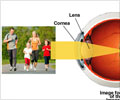
Using a combination of techniques known as microstereolithography and electrospinning, the researchers are able to make a disc of biodegradable material, which can be fixed over the cornea. The disc is loaded with stem cells that then multiply, allowing the body to heal the eye naturally.
"The disc has an outer ring containing pockets into which stem cells taken from the patient's healthy eye can be placed," explained EPSRC Fellow, Dr Ilida Ortega Asencio, from Sheffield's Faculty of Engineering.
"The material across the centre of the disc is thinner than the ring, so it will biodegrade more quickly allowing the stem cells to proliferate across the surface of the eye to repair the cornea," she said.
A key feature of the disc is that it contains niches or pockets to house and protect the stem cells, mirroring niches found around the rim of a healthy cornea.
Standard treatments for corneal blindness are corneal transplants or grafting stem cells onto the eye using donor human amniotic membrane as a temporary carrier to deliver these cells to the eye. For some patients, the treatment can fail after a few years, as the repaired eyes do not retain these stem cells, which are required to carry out on-going repair of the cornea.
Advertisement
"Laboratory tests have shown that the membranes will support cell growth, so the next stage is to trial this in patients in India, working with our colleagues in the LV Prasad Eye Institute in Hyderabad," said Professor Sheila MacNeil.
Advertisement
The new technology has been described in detail in the journal Acta Biomaterialia.
Source-ANI











